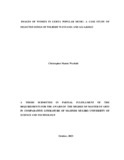| dc.description.abstract | The study, ‘Images of women in Luhya Popular Music: a case study of Selected Songs of Wilbert Wanyama and Ali Akeko’ sets out to examine selected popular songs with a view to explore the portrayal of images of women in the popular songs composed and performed by the two selected Luhya artists. The impetus of this study was borne out of the realization that popular songs whose medium of communication is music have become an important avenue for social communication as a form of text, and popular songs do not exist in isolation of the people who produce and consume them. Popular songs projected through music communicate seductively to their audience imposing on them the need to take positions on day to day issues. The study aimed to explore the images of women portrayed in the selectd popular songs of Ali Akeko and Wilbert Wanyama, interrogate the gendered socio-cultural attitudes and gender roles in the Wanga, Bukusu and Banyala societies as revealed through the popular songs of Akeko and Wanyama and finally, examine the strategies employed by Wanyama and Akeko in depicting women images. This study was guided by research questions such as: Which images of women emanate from the popular songs of Ali Akeko and Wilbert Wanyama? How do the popular songs of Akeko and Wanyama reveal the gendered socio-cultural attitudes and gender roles in the Wanga, Bukusu and Banyala societies? Which strategies are employed by Wanyama and Akeko in depicting women images? To help rationalize the area of engagement, the study used Ethnopoetics and feminist literary criticism for conceptual analysis and interpretation of the texts. Feminist literary criticism was significant in helping us to understand how women are portrayed in the Luhya songs of Akeko and Wanyama. Ethnopoetics helped us to actualize the seleted oral songs into a written text and in unraveling the meaning and mood in the selected songs of Wanyama and Akeko. Critical analysis of the songs and mixed method research that uses a sequential exploratory design were useful in collecting data. Purposive sampling was used in the selection of the songs which were taken as cultural texts that portray women in their images and reveal their gender roles and stereotypes. These texts were subjected to literary analysis to appreciate their content and aesthetic wealth, and further apprehend the treatment of women both metaphorically and non metaphorically in the songs. The study revealed that the songs of the two musicians have gendered discourses that depict women both positively and negatively in their various capacities, the Luhya popular songs of Akeko and Wanyama reveal soceietal gendered socio-cultural attitudes and gender roles on women where by certain duties are only performed by women and not men. The findings of this study will shed light on the societal attitudes towards women in the wider Luhya community that the two artists come from. This study will help literary scholars, gender activists, musicians and sociologists to delve further in gender dynamics of the community and improve their areas of concern especially in relation to the Luhya community. | en_US |

